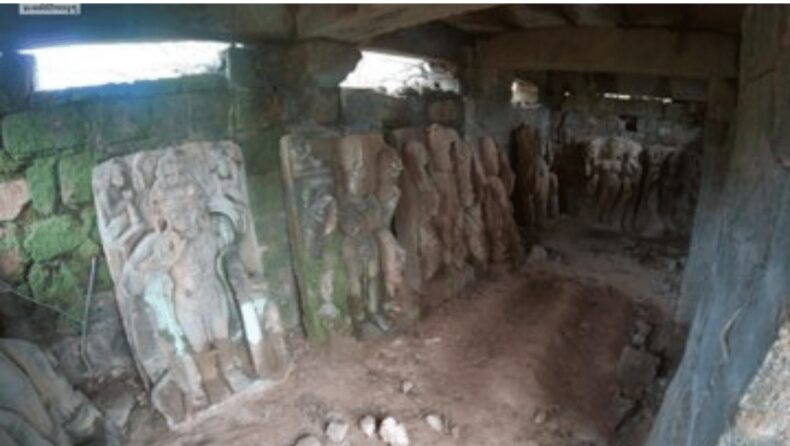Archaeological Survey of India conducted a major exploration on Wednesday at Bandhavgarh Tiger Reserve in Madhya Pradesh.
During exploration, ASI found ancient caves and temples, mural inscriptions relevant to names of cities like Kaushambi, Sepatanaairikaa, Vejabharada, Parvata and Mathura in old scripts like Brahmi, Nagari and Shankhalipi etc and remains of Buddhist structures from period of 2nd century to 5th century of the Mahayana sect.
Besides, one of the historical findings was the huge sculpture of Lord Vishnu avatar ‘Varaha’ belongs to the period from the 9th century to 13th century CE.
ASI’s first exploration at Tiger reserve since 1938
Since 1938, this was the first time ASI conducted exploration at Bandhavgarh Tiger Reserve, ASI officials said.
The Archaeological Survey of India has resolved the incredible archaeological remains at the Bandhavgarh Tiger Reserve and covered over 170 sq km in the premises of the Bandhavgarh Tiger Reserve.
During the time of the exploration exercise, the public is not allowed for visits to Tiger Reserve for over a month.
Archaeological Survey of India treasure trove
In an exploration, 24 Brahmi inscriptions and 26 caves are discovered and mostly belong to the Buddhist religion and date back to the 2nd century to the 5th century BC.
Besides 46 sculptures, two monasteries and 26 temples and the remains of the Kalachuri period have been explored with a total of 35 temples have been documented so far.

Among other findings, two votive stupas of the Kalachuri period date back from the 9th century to the 11th century.
A Buddhist pillar pieces containing miniature stupa carvings belonging to the period from the 2nd century BC to the 5th century BC and 19 water structures from the different periods from 2nd century to 15th century CE and other scattered remains have been documented as part of exploration, an ASI official statement said
In explorations, coins belonging to the Mughal era and the Shari dynasty of the Jaunpur sultanate have also been reported.

The Jabalpur circle of Archaeological Survey of India also reported many ancient sculptures including large monolithic ones of Lord Vishnu’s first avatar ‘Matsya’ and third avatar ‘Varaha’ and board games made in natural caves. an ASI official said.
The exploration drive at the tiger reserve was exercised between May 20 to June 27.
The found inscriptions and sculptors from the period of the findings covered the reigns of the king Maharaja Bhattadeva, Maharaja Pothasiri and Maharaja Bhimsena been engraved.
Bandhavgarh Tiger Reserve
The Tiger Reserve is part of the Bandhavgarh National Park situated in the Umaria district of Madhya Pradesh.
In 1968, Bandhavgarh has declared a National Park with an area of 105 square kilometres and in 1993, it became Tiger Reserve.
The area of the National park is spread over 716 square kilometres with a large biodiversity.
Bandhavgarh’s name is derived from two words Bandhav means brother and Garh meaning fort.
The name of the park is derived from the famous hill of the area, which is said to be given by Lord Rama to his brother Laxman to watch the Lanka fort built by the Gond dynasty king.
Minister for Culture and ASI tweets
Minister of Tourism, Culture and Development of North Eastern Region of India.
Union Minister of Tourism, Culture and Development of NERI, Gangapuram Kishan Reddy tweeted the latest exploration drive conducted in the Bandhavgarh Tiger reserve.
From his tweet “In Bandhavgarh Forest Reserve, remarkable archaeological remains are unravelled by @ASIGoI. 26 temples, 26 caves, 2 monasteries, 2 votive stupas, 24 inscriptions, 46 sculptures, other scattered remains & 19 water structures are recorded. The Varah here is one of the largest”.
Archaeological Survey of India under the Ministry of Culture, Government of India also tweeted about its exploration exercise.
“In Bandhavgarh Forest Reserve, remarkable archaeological remains were unravelled by @ASIGoI. In an exploration 26 temples, 26 caves, 2 monasteries, 2 votive stupas, 24 inscriptions, 46 sculptures, other scattered remains & 19 water structures are recorded”. (1/3)
“The period of the findings covered the reigns of the kings Shri Bhimsena, Maharaja Pothasiri, and Maharaja Bhattadeva. Places deciphered in the inscriptions are Kaushami, Mathura, Pavata (Parvata), Vejabharada and Sapatanaairikaa”. (2/3)
“An ASI team covered nearly 170 sq km falling in the area of the Bandhavgarh Tiger Reserve over a months-long exploration of the region which was undertaken for the first time since 1938. The exploration was conducted by the Jabalpur Circle of ASI”. (3/3)













